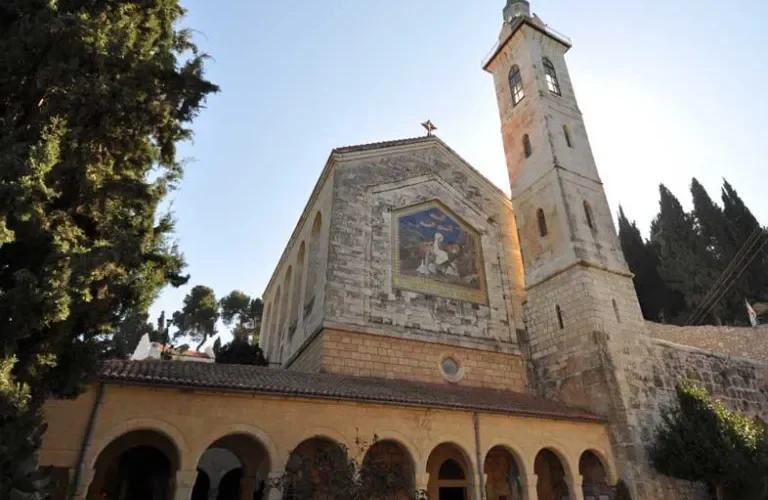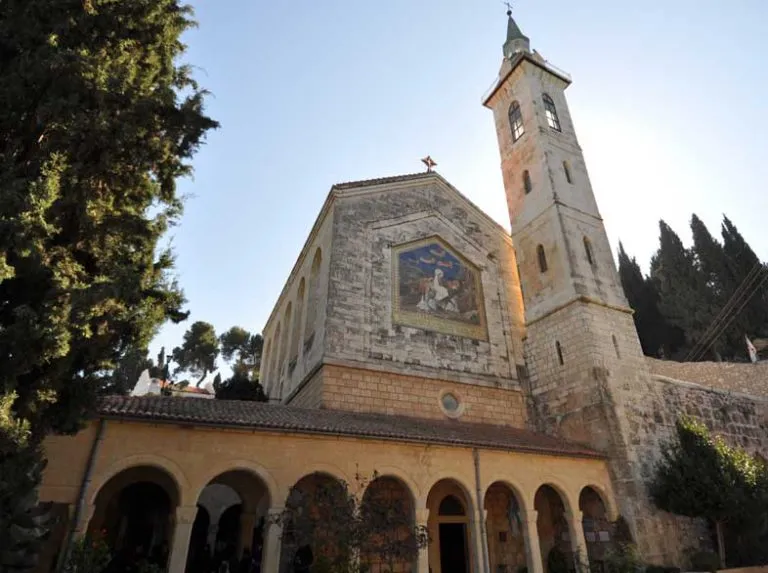
Introduction
The Church of the Visitation (formerly Abbey Church of St John in the Woods) is a Catholic church in Ein Karem, Jerusalem, and honors the visit paid by the Virgin Mary, the mother of Jesus, to Elizabeth, the mother of John the Baptist. When the two women met, Mary uttered her song of praise, the Magnificent. The church courtyard is beautifully adorned with tiled representations of that canticle in numerous languages. A tranquil garden links a contemplative cave-chapel marking the site of the Mary and Elizabeth’s meeting to the grand church above.
The Virgin Mary’s visit to Elizabeth depicted in mosaic on the façade is commemorated in a two-tiered church. Completed in 1955 to a design by Antonio Barluzzi, the artistically decorated Church of the Visitation is considered one of the most beautiful of all the Gospel sites in the Holy Land.
The church is built against a rocky slope where an opening is believed to be where Elizabeth and her infant John hid when Herod ordered the execution of all male children under two years old. This is believed to be the site of Zechariah and Elizabeth’s summer house, where Mary came to visit her cousin. On the wall opposite the church, ceramic plaques reproduce Mary’s canticle of praise, the Magnificat in some 50 languages.
In the lower chapel, a vaulted passage leads to an old well. An ancient tradition asserts that a spring joyfully burst out of the rock here when Mary greeted Elizabeth. A huge stone set in a niche is known as the Stone of Hiding. According to an ancient tradition, the stone opened to provide a hiding place for the baby John during Herod’s Massacre of the Innocents an event depicted in a painting on the wall.
History of Church of the Visitation, Ein Karem
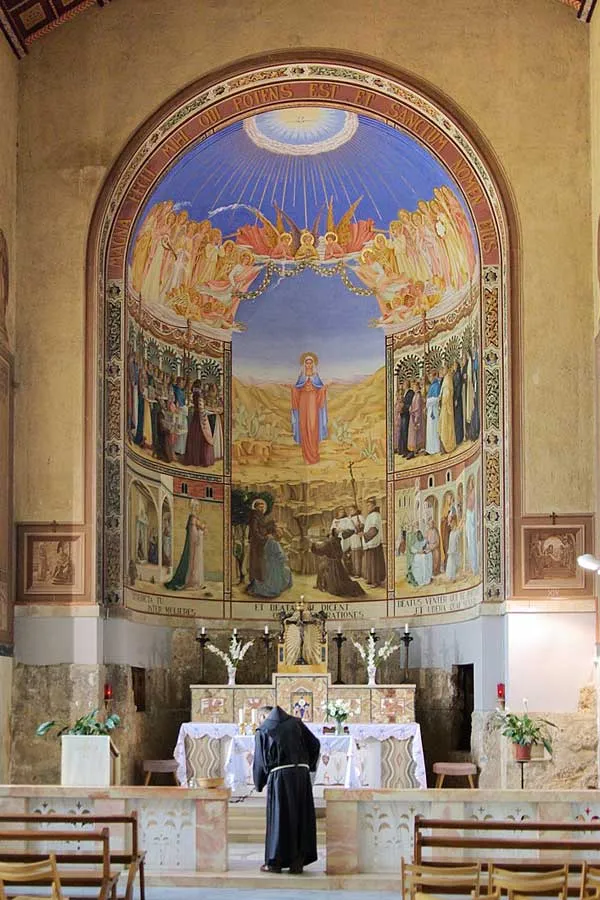
Christian tradition places the birth of John the Baptist who announced the coming of Jesus Christ, his cousin in the picturesque village of Ein Karem 7.5 km south-west of Jerusalem. The angel Gabriel appeared to the elderly priest Zechariah while he was serving in the Temple and told him that his wife Elizabeth was to bear a son. Zechariah was sceptical, so he was struck dumb and remained so until the baby John was born.
In the meantime, Gabriel appeared to the teenage Virgin Mary in Nazareth, telling her that she was to become the mother of Jesus. As proof, he revealed that Mary’s elderly cousin Elizabeth was already six months’ pregnant.
Mary then “went with haste to a Judean town in the hill country” a distance of around 120 km “where she entered the house of Zechariah and greeted Elizabeth. When Elizabeth heard Mary’s greeting, the child leaped in her womb.”
The Bible doesn’t mention the birth place of John, it only states that Mary went to “a town in the hill country of Judea”. One tradition attributes the construction of the first church of Ein Karem to Empress Helena of Constantinople, Constantine I’s mother, who identified the site as the home of John’s father, Zachary.
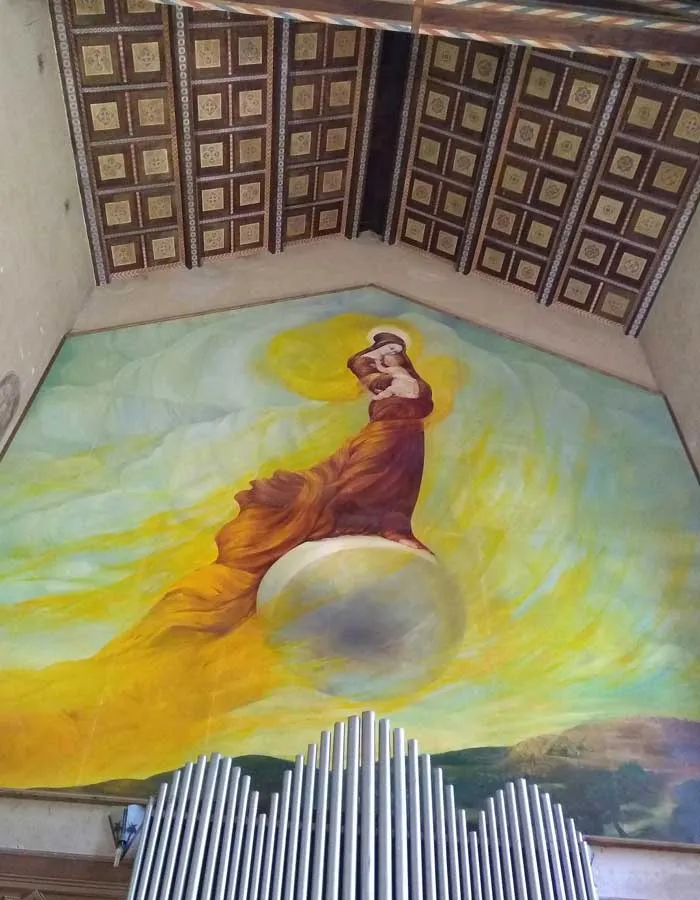
Church of the Nativity of St John the Baptist
From the Crusader conquest of the Holy Land onwards, three different locations in Ein Karem became connected with the life of St John the Baptist and turned into points of interest for pilgrims: a cave within the village, a site on a hill south of it, and the village’s main water fountain. The events connected to the sites are the meeting between Mary and her cousin Elizabeth, the home of Zachary and Elizabeth, the birth of John, and the hiding place of Elizabeth and John.
The Crusaders erected two main churches in Ein Karem, the precursors of what are today the Church of St John the Baptist and the Church of the Visitation. After the departure of the Crusaders, the different traditions shifted back and forth between the two locations.
The Catholic Church of the Nativity of St John, identifiable by its tall tower topped by a round spire. It is also called “St John in the mountains”, a reference to the “hill country” of the Scripture.
The church combines remnants of many periods. An early church on this site was used by Muslim villagers for their livestock before the Franciscans recovered it in the 17th century. The Franciscans built the present church with the help of the Spanish monarchy.
The high altar is dedicated to St John. To the right is Elizabeth’s altar. To the left are steps leading down to a natural grotto identified as John’s birthplace and believed to be part of his parents’ home. A chapel beneath the porch contains two tombs. An inscription in a mosaic panel reads, in Greek, “Hail martyrs of God”. Whom it refers to is unknown.
At the site of the Church of the Visitation, the Crusaders erected a two-story church dedicated to the meeting between Elizabeth and Mary over the ancient ruins they found here.
Visitation of Mary
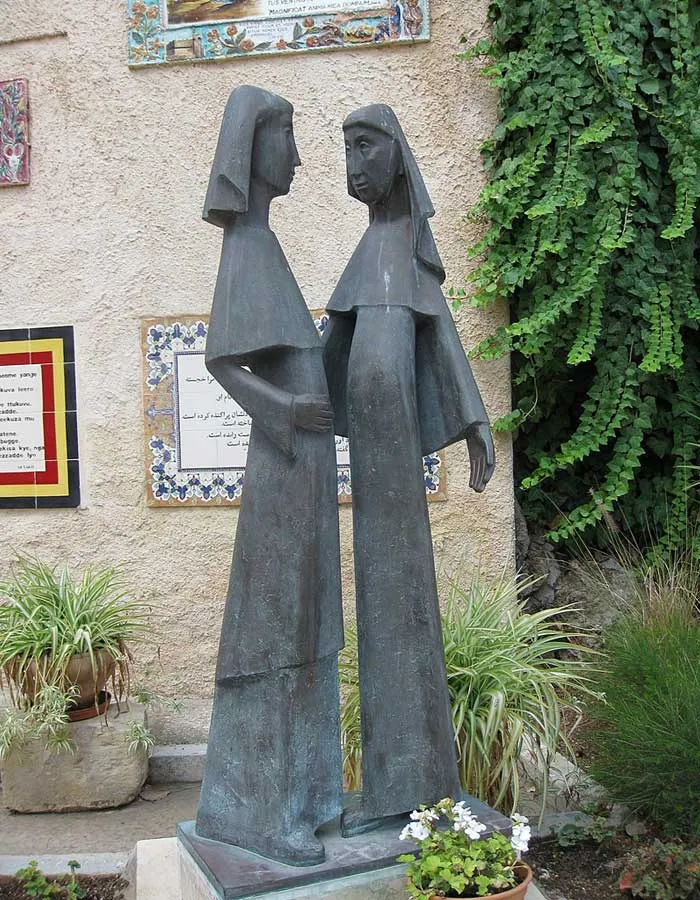
In Christianity, the Visitation is the visit of Mary, who was pregnant with Jesus, to Elizabeth, who was pregnant with John the Baptist, in the Gospel of Luke, Luke 1:39–56.
It is also the name of a Christian feast day commemorating this visit, celebrated on 31 May in the feast-celebrating branches of Western Christianity (most and mainstream calendars of Catholics and High Church Anglicans (or as 2 July in calendars of 1263–1969, retained in the modern calendar of some countries whose bishops’ conferences wanted to retain this, notably Germany and Slovakia) and 30 March in Eastern Christianity.
The episode is one of the standard scenes shown in cycles of the Life of the Virgin in art, and sometimes in larger cycles of the Life of Christ in art.
History of Visitation of Mary
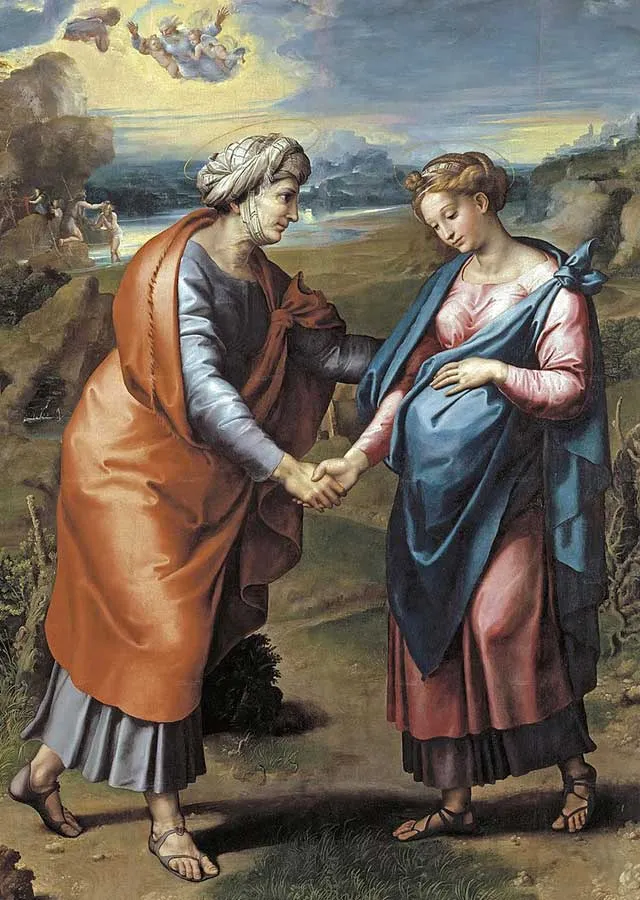
Mary visits her relative Elizabeth; they are both pregnant: Mary with Jesus, and Elizabeth with John the Baptist. Mary left Nazareth immediately after the Annunciation and went “into the hill country into a city of Judah” (Luke 1:39) to attend to her cousin (Luke 1:36) Elizabeth. There are several possibilities as to exactly which city this was, including Hebron, south of Jerusalem, and Ein Karem.
The journey from Nazareth to Hebron is about 130 kilometres (81 mi) in a direct line, probably up to half as far again by road, depending on the route taken. Elizabeth was in the sixth month before Mary came (Luke 1:36). Mary stayed three months, and most scholars hold she stayed for the birth of John.
Given the prevailing cultural traditions and needs for security, it is probable that Joseph accompanied Mary to Judah then returned to Nazareth, and came again after three months to take his wife home. The apparition of the angel, mentioned in Matthew 1:19–25, may have taken place then to end the tormenting doubts of Joseph regarding Mary’s maternity.
In the Gospel of Luke, the author’s accounts of the Annunciation and Visitation are constructed using eight points of literary parallelism to compare Mary to the Ark of the Covenant.
Some Catholic commentators have maintained that the purpose of this visit was to bring divine grace to both Elizabeth and her unborn child. Even though he was still in his mother’s womb, John became aware of the presence of Christ, and leapt for joy as he was cleansed from original sin and filled with divine grace. Elizabeth also responded and recognised the presence of Jesus, and thus Mary exercised her function as mediatrix between God and man for the first time.
And she [Elizabeth] spoke out with a loud voice, and said, “Blessed [art] thou among women, and blessed [is] the fruit of thy womb. And whence [is] this to me, that the mother of my Lord should come to me? For, lo, as soon as the voice of thy salutation sounded in mine ears, the babe leaped in my womb for joy. And blessed [is] she that believed: for there shall be a performance of those things which were told her from the Lord.”
In response to Elizabeth, Mary proclaims the Magnificat (My soul doth magnify the Lord). The word “blessed” is rendered in Greek not by the word “makarios” but as “evlogimeni”, which is the feminine second person singular, used only this once in the New Testament. Its masculine third person singular counterpart “evlogimenos” is used only for Jesus and only on this occasion and when he was welcomed into Jerusalem on Palm Sunday with: “Blessed is he who comes in the name of the Lord”. The masculine, mixed gender third person plural “evlogimenoi” is used by Jesus only when referring to the righteous who are to be raised to life in the Last Judgement.
Courtyard, Exterior and Annexes
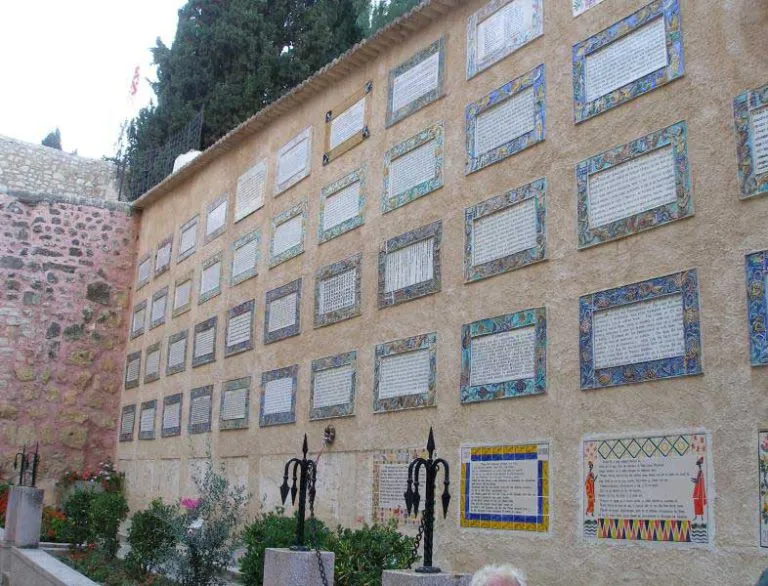
The courtyard contains a statue of Mary and Elizabeth, and on the wall opposite the entrance to the lower church are forty-two ceramic tablets bearing the verses of the Magnificat in as many different languages. On the facade of the upper church is a striking mosaic commemorating the Visitation. Next to the church proper, a Crusader hall of the 12th century survived in good condition.
Lower Church
The lower church contains a narrow medieval barrel-vaulted crypt ending with a well-head from which, according to tradition, Elizabeth and her infant drank. The well is connected to a Roman or Byzantine overflow pipe running under the medieval floor. Also preserved are remains of the ancient church and beautiful mosaic floors.
The rock with a cleft next to the entrance of the medieval crypt is said to mark the site where the mountain opened up to hide Elizabeth and the infant John from Herod’s soldiers – this is the “Rock of Concealment”. The interior of the lower church holds Italianate frescoes depicting Zachary at the altar of the Lord, the Visitation, and Elizabeth hiding her son during the Massacre of the Innocents.
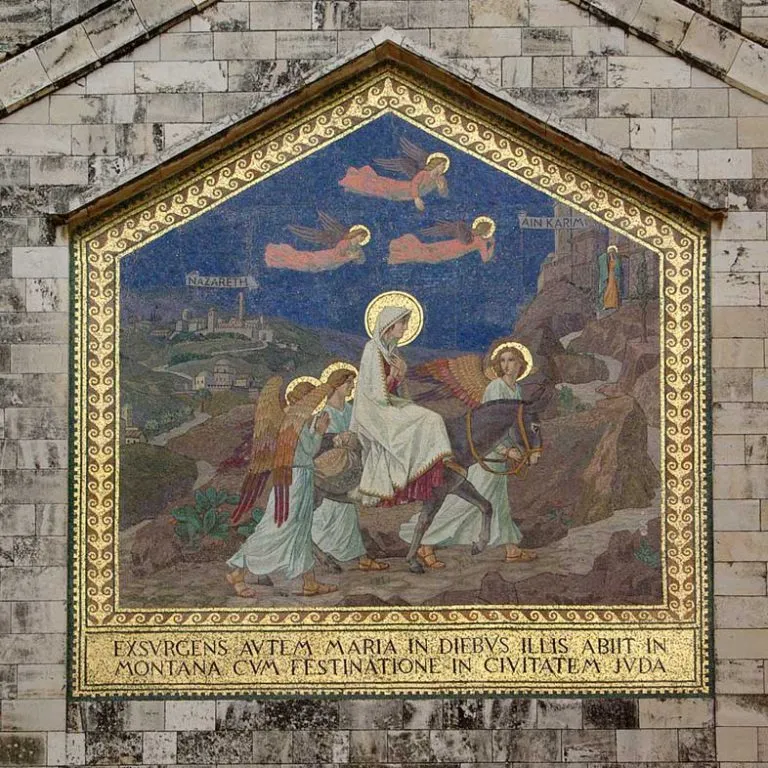
Upper Church
The walls of the upper church are decorated with frescoes. Those on the southern wall are depicting five episodes, from left (east) to right (west):
- The Council of Ephesus, which defined Mary as Theotokos or the Mother of God;
- Mary protecting Christians with her mantle, according to the oldest extant hymn to the Blessed Virgin Mary as Theotokos, the Sub tuum praesidium;
- The Wedding at Cana;
- The Battle of Lepanto (1571), in which a united Catholic fleet defeated an Ottoman fleet, a victory ascribed to the help of the Virgin Mary under the title Mary Help of Christians and celebrated by the Catholic Church with the feast of Our Lady of the Rosary;
- Duns Scotus, supported by the Franciscans, defending his thesis on the Immaculate Conception at the Sorbonne in Paris against the dissenting Dominicans.
Behind the altar, a fresco is showing Mary approaching through Judaea, with the Franciscan custos presenting her the model of the church and the Catholic patriarch of Jerusalem of the time in attendance.
Verses from the Magnificat are painted on the columns of the church. In the corners are the four cardinal virtues, and around the windows on the left side of the church are Christian writers (Fathers and Doctors of the Church) who have written about the Virgin Mary. The ceiling is painted in the Tuscan style of the 14th century.
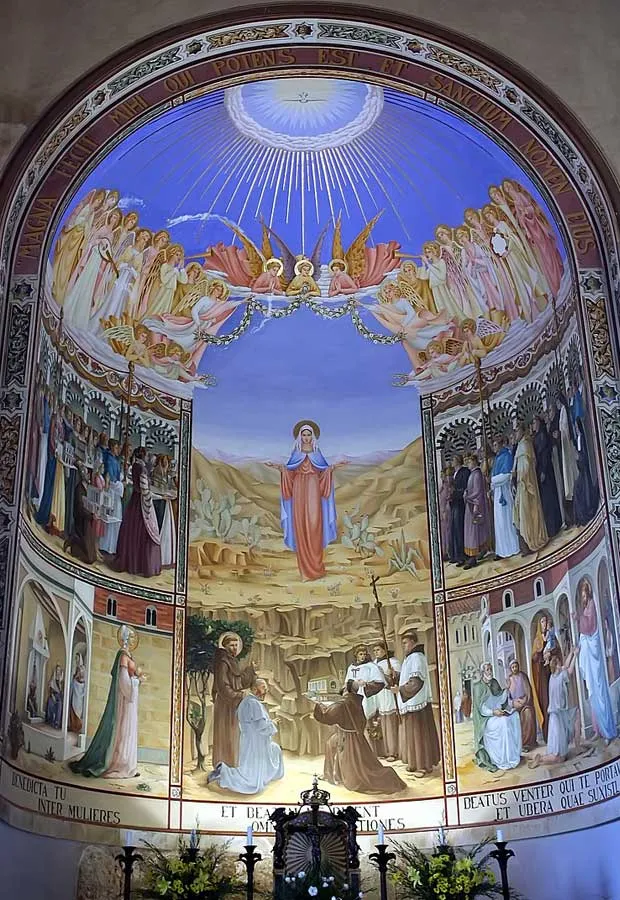
Two Sites for Two Houses
The two main sites in the “Judean town” of Ein Karem are linked to the understanding that Zechariah and Elizabeth had two houses in Ein Karem. Their usual residence was in the valley. But a cooler summer house, high on a hillside, allowed them to escape the heat and humidity. The summer house is believed to be where the pregnant Elizabeth “remained in seclusion for five months” and where Mary visited her.
The house in the valley is where John the Baptist was born. Here, also, old Zechariah finally regained his power of speech after his son was born, when he obediently wrote on a writing tablet that the baby’s name was to be John.
Ein Karem is still a tranquil place of trees and vineyards, but the municipality of Jerusalem has spread to incorporate the former Arab village. It is now a town of Jewish artisans and craftspeople, but Christian churches and convents abound.
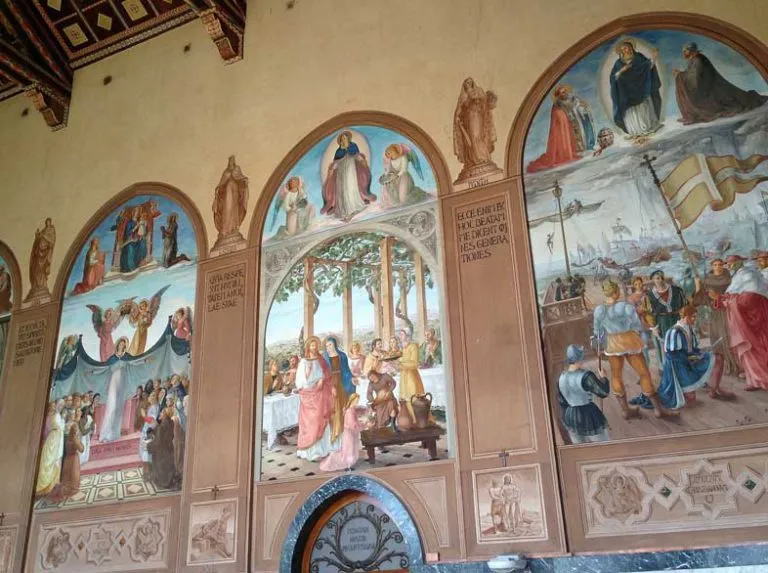
Mary’s Spring and the Desert of St John
In a valley on the south of the village is a fresh-water spring known as Mary’s Spring or the Fountain of the Virgin. Tradition has it that Mary quenched her thirst from this spring before ascending the hill to meet Elizabeth. The water has become contaminated and is no longer safe to drink.
The spring gives the village its name from the Arabic “ein” (spring) and kerem (vineyard or olive grove). Built over the spring is a small abandoned mosque, another reminder that this was once an Arab village.
South-west of Ein Karem, off Route 386, a Greek Melkite monastery and a Franciscan convent mark the Desert of St John, a site where John the Baptist is believed to have lived in seclusion.
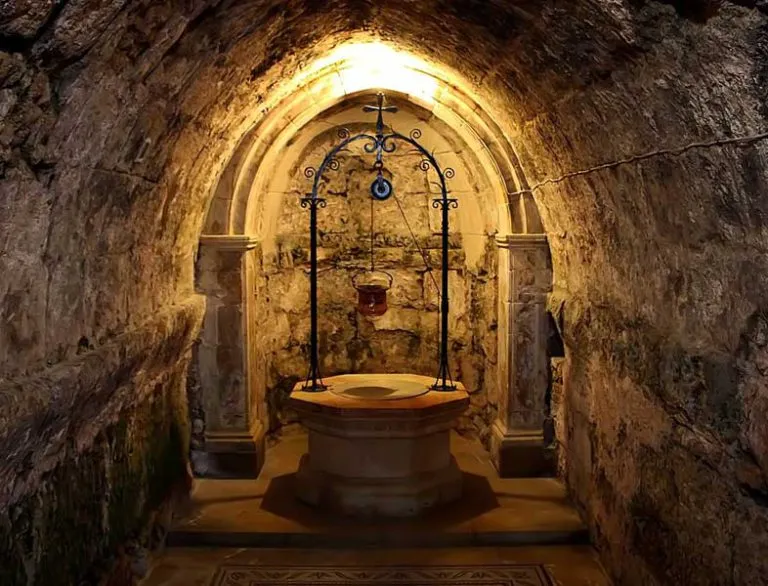
Feast Day - 30th March
Annual Feast Day of Visitation of Mary held on 30th March.
Mass Time
Every Days
Church Visiting Time
Contact Info
Ein Karem, Jerusalem, Israel.
Phone No.
Tel : +972 2-641-7291
Accommodations
How to reach the Church
Ben Gurion International Airport in Israel is the nearby Airport to the Church.
Har Herzl Light Rail Station in Jerusalem, Israel is the nearby Train Station to the Church.

